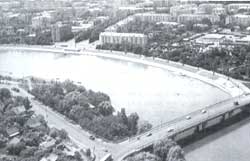Russia`s nightmare
 RUSSIA today is sitting on a bomb - thousands of bombs really. The real nightmare is not that it cannot get rid of more than 36,000 metric tonne of chemical weapons, but that it cannot find the thousands of bombs that lie in abandoned and uncharted weapons dumps, according to a report in the International Herald Tribune.
RUSSIA today is sitting on a bomb - thousands of bombs really. The real nightmare is not that it cannot get rid of more than 36,000 metric tonne of chemical weapons, but that it cannot find the thousands of bombs that lie in abandoned and uncharted weapons dumps, according to a report in the International Herald Tribune.
The pine forest in Leonidovka, a small village in Russia, is one such uncharted chemical weapons graveyard. Buried here are vintage World War 11 aerial bombs, filled with a mixture of deadly lewisite, a blistering poison gas and another sulphuric mustard gas. This area is protected by only one distant sign warning people to keep out. Entombed in the forest by Soviet soldiers in the early 1960s and then forgotten, the bombs are coming back to haunt the environment in Russia. The Russian military, which created these undeclared dumps decades ago, denies their existence.
Russia has more chemical bombs than any other country in the world. Vladimir Pankratov, earlier with the Soviet military, is an environmentalist today. He has taken upon himself to investigate the environmental and health hazards due to these undeclared dumps. Preliminary tests by a team of experts working with Pankratov have found heavy concentration of arsenic in the soil in Leonidovka. Lewisite is 36 per cent arsenic. The poison is spreading and is affecting hundreds of thousands of people who live in Leonidovka, says the report.
Water and soil tests by Pankratov's team reveal that the Sursk Reservoir is affected by arsenic pollution. The reservoir provides drinking water for Penza, the nearby provincial capital, with a population of 530,000. Penza is part of the Volga River basin, which was home to much of the Soviet chemical warfare industry. Arsenic is extremely toxic. In acute poisoning, violent stomach and intestinal inflammation and bleeding lead to massive losses of fluid and electrolytes, causing collapse, shock and death. Long term exposure can also lead to cancer.
A full accounting of the environmental degradation did not take place when the Soviet Union collapsed. During the Cold War, the Soviet Union did not disclose the sources of this pollution - the arsenals and bomb factories. Not much is known about the dumping and destruction of chemical and radioactive materials. The report says that whenever there is some investigation, the authorities deny that there is any threat to the environment and classify the relevant documents as "top secret". No one knows where the buried weapons are, or how much of deadly poisons are polluting the air, water and soil, says the report.
"Information about old destruction sites has not been opened, it is still classified and we are talking about it now because we have to face the consequences," says Pankratov, "We are talking about a dangerous contamination of the soil," he says. Vladimir Verzhbovsky, a journalist in Penza says: "Those who try to rouse public opinion are treated as clowns and not taken seriously. Life is so hard. Salaries have not been paid for many months".
The contamination may become an enormous economic burden for Russia. Russia, which is in the midst of an economic crisis, cannot afford to clean up the poisons left behind by 50 years of dumping and discharge by the military and its bomb-making industry.
